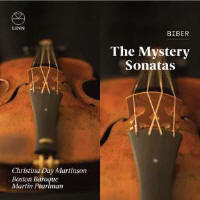Texte paru dans: / Appeared in: |
|
|
Reviewer: Raymond
Tuttle
These works, also known as the
Rosary Sonatas, have become very popular among Baroque violinists in recent
years, and recordings of them are fairly thick on the ground. This one
essentially is a Boston Baroque production, as Martinson and Unterman are
principal players with that ensemble, and Pearlman is its music director.
The work comprises 15 sonatas, divided into three sets of five: “The Joyful
Mysteries,” “The Sorrowful Mysteries,” and “The Glorious Mysteries.” Each
sonata (usually, but not always in three movements) is named after an
episode in Christ’s history. For example, Sonata I is named “The
Annunciation,” and Sonata VI is named “The Agony in the Garden.” Some
recordings, such as Andrew Manze’s highly touted version for Harmonia Mundi
(Want Listed here in 2005 by Robert Maxham), track each movement separately.
This one tracks only the sonatas, which might be less helpful for listeners,
although doing so probably was intended to emphasize the unity of each of
the works.
Most of the sonatas require
the violin to be tuned in a non-traditional way, which is known as
scordatura. These alternate tunings give the violin a different sound. In
the case of Sonata XI, which depicts Christ’s resurrection, the middle two
strings are crossed in the instrument’s peg box, and the resulting visual
“cross” has symbolic significance, even though only the performer can see
it. In live performances, these tunings can create practical challenges, but
obviously it is less difficult to manage them in a recording studio.
Nevertheless, Martinson uses several violins on this disc, although we are
not told exactly how many or who their makers were. At the start of each
sonata, Martinson helpfully demonstrates the tuning that is being used by
bowing up and down the four open strings—some listeners will not like this,
I imagine—and the tuning also is printed in the accompanying booklet.
I agree with Maxham that the
Manze set (with Richard Egarr playing harpsichord and organ) is quite an
achievement, although I have been living with it for only about three
months. Manze plays the music with considerable imagination, but his sound
is essentially sweet and well groomed, and what I would call Italianate. The
approach, while refined, is always emotional and expressive. It emphasizes
the mystery in these Mystery Sonatas. In contrast, Martinson’s sound is
rougher and more ascetic. The word “penitential” comes to mind. Martinson is
an ill-clothed hermit praying and flagellating herself in the wilderness,
while Manze is in more comfortable, even sentimental surroundings, although
I don’t doubt his sincerity. Perhaps Martinson’s performance is more about
the body, and Manze’s is more about the soul. Martinson and her colleagues
also are appreciably faster in almost all of the sonatas, and pitched a
little lower. Also, from sonata to sonata, there are differences in the
instruments used to support the violin and the keyboard. For example, in
Sonata VI, Martinson and Pearlman are joined by the other two musicians
listed in the headnote. In contrast, Manze and Egarr, perhaps symbolically,
go it alone on their recording. Both releases feature excellent engineering.
Linn’s sound is extremely immediate; one can almost see Martinson standing
in front of you with her instrument. Harmonia Mundi’s sound, like the
performance itself, is smoother, with an impressive presence given to the
organ’s bass notes.
The Passacaglia for Solo
Violin is common to both releases, and each performance has virtues similar
to those found in the rest of the program. Here, I think I prefer
Martinson’s more straightforward approach; Manze can sound a little fussy.
Manze’s recording includes a bonus track in which he explains and
demonstrates scordatura. It is interesting to hear—once. If you’re an enemy of period instrument performances, the present release will not change your mind. That said, Martinson, Pearlman, and colleagues definitely have a strong, even assertive point of view, and I have no problem recommending this release for those who want to hear Biber’s visionary music played in a less comfortable manner. | |
|
|
|
|
|
|
|
Cliquez l'un ou l'autre
bouton pour découvrir bien d'autres critiques de CD |
|




